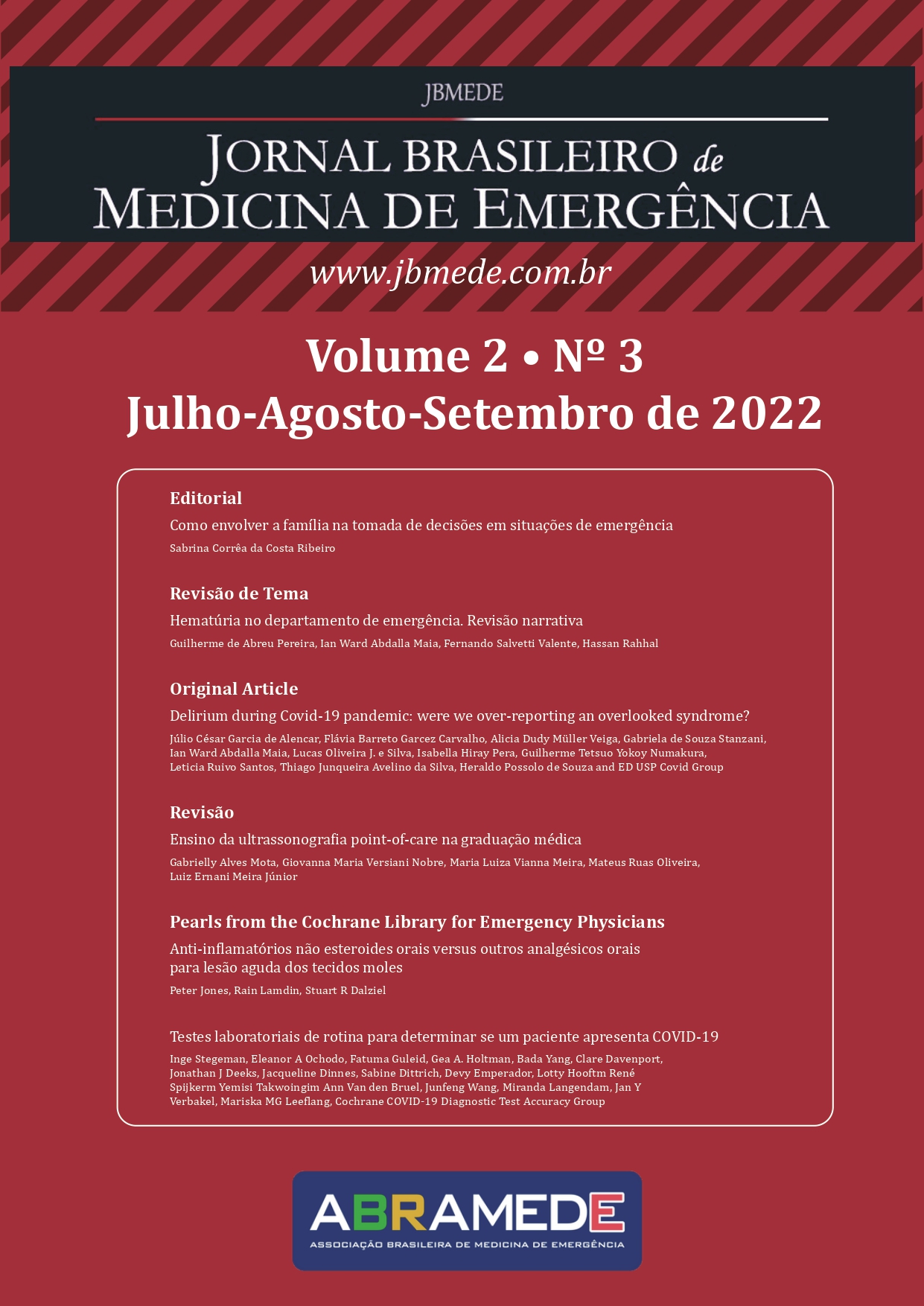Delirium during Covid-19 pandemic: were we over-reporting an overlooked syndrome?
Main Article Content
Abstract
Objective: To compare incidence of delirium in Emergency Department in elderly patients admitted for SARS-CoV-2 infection and sepsis for other etiologies. Methods: This observational study analyzed elderly patients (>65 years) from two cohort studies that recruited patients in an urban and academic Emergency Department. The first cohort studied septic patients before Covid-19 pandemic and was conducted between September 30, 2019, and March 17, 2020. The second cohort studied Covid-19 patients between April 8, 2021, and May 28, 2021. Our primary outcome was the incidence of delirium at admission in Emergency Department, which we defined using the Confusion Assessment Method. Results: We included 141 patients in our final analysis, with a median age of 72 (interquartile range: 68 to 79) years and a predominance of the male sex (58%). We identified delirium at admission in 31 participants (21%) in septic non-Covid group and 11 (24%) in Covid-19 group (p=0.70). Conclusion: This present study does not support that elderly patients with Covid-19 have higher risk for delirium at admission in Emergency Department when compared to patients hospitalized with sepsis for other etiologies. Although sepsis for Covid-19 have had more than 28% mortality, Covid-19 was not associated with higher mortality in elderly than sepsis for other etiologies. The study protocol was approved by the local Research Ethics Committee (CAPPESq, protocol number 30417520.0.0000.0068).
Article Details

This work is licensed under a Creative Commons Attribution 4.0 International License.
References
Oliveira J E Silva L, Berning MJ, Stanich JA, Gerberi DJ, Murad
MH, Han JH, et al. Risk factors for delirium in older adults in the
emergency department: a systematic review and meta-analysis.
Ann Emerg Med. 2021;78(4):549-65.
Barron EA, Holmes J. Delirium within the emergency care setting,
occurrence and detection: a systematic review. Emerg Med J.
;30(4):263-8
Inouye SK, Westendorp RG, Saczynski JS. Delirium in elderly
people. Lancet. 2014;383(9920):911-22.
Suffoletto B, Miller T, Frisch A, Callaway C. Emergency physician
recognition of delirium. Postgrad Med J. 2013;89(1057):621-5.
Mao L, Jin H, Wang M, Hu Y, Chen S, He Q, et al. Neurologic
Manifestations of Hospitalized Patients With Coronavirus Disease
in Wuhan, China. JAMA Neurol. 2020;77(6):683-90.
Romero-Sánchez CM, Díaz-Maroto I, Fernández-Díaz E, Sánchez-
Larsen Á, Layos-Romero A, García-García J, et al. Neurologic
manifestations in hospitalized patients with Covid-19: The
ALBACovid registry. Neurology. 2020;95(8):e1060-e1070.
Romoli M, Jelcic I, Bernard-Valnet R, García Azorín D, Mancinelli
L, Akhvlediani T, et al.; Infectious Disease Panel of the European
Academy of Neurology. A systematic review of neurological
manifestations of SARS-CoV-2 infection: the devil is hidden in the
details. Eur J Neurol. 2020;27(9):1712-26.
Kennedy M, Helfand BKI, Gou RY, Gartaganis SL, Webb M, Moccia
JM, et al. Delirium in older patients with Covid-19 presenting to the
emergency department. JAMA Netw Open. 2020;3(11):e2029540.
von Elm E, Altman DG, Egger M, Pocock SJ, Gøtzsche PC,
Vandenbroucke JP; STROBE Initiative. The Strengthening the
Reporting of Observational Studies in Epidemiology (STROBE)
statement: guidelines for reporting observational studies. J Clin
Epidemiol. 2008;61(4):344-9.
Singer M, Deutschman CS, Seymour C, Shankar-Hari M, Annane
D, Bauer M, et al. The third international consensus definitions for
sepsis and septic shock (sepsis-3). JAMA. 2016;315(8):801-10.
Harris PA, Taylor R, Minor BL, Elliott V, Fernandez M, O’Neal L, et
al.; REDCap Consortium. The REDCap consortium: Building an
international community of software platform partners. J Biomed
Inform. 2019;95:103208.
Inouye SK, van Dyck CH, Alessi CA, Balkin S, Siegal AP, Horwitz RI.
Clarifying confusion: the Confusion assessment Method. A new
method for detection of delirium. Ann Intern Med. 1990;113(12):941-8.
Fabbri RM, Moreira MA, Garrido R, Almeida OP. Validity and
reliability of the Portuguese version of the Confusion Assessment
Method (CAM) for the detection of delirium in the elderly. Arq
Neuropsiquiatr. 2001;59(2-A):175-9.
Kennedy M, Enander RA, Tadiri SP, Wolfe RE, Shapiro NI,
Marcantonio ER. Delirium risk prediction, healthcare use and
mortality of elderly adults in the emergency department. J Am
Geriatr Soc. 2014;62(3):462-9.
Garcez FB, Aliberti MJ, Poco PC, Hiratsuka M, Takahashi SF, Coelho
VA, et al. Delirium and adverse outcomes in hospitalized patients
with Covid-19. J Am Geriatr Soc. 2020;68(11):2440-6.
Ahmed S, Leurent B, Sampson EL. Risk factors for incident delirium
among older people in acute hospital medical units: a systematic
review and meta-analysis. Age Ageing. 2014;43(3):326-33.
Melo SC, Champs AP, Goulart RF, Malta DC, Passos VM. Dementias
in Brazil: Increasing burden in the 2000-2016 period. Estimates
from the Global Burden of Disease Study 2016. Arq Neuropsiquiatr.
;78(12):762-71.
Wu Y, Xu X, Chen Z, Duan J, Hashimoto K, Yang L, et al. Nervous
system involvement after infection with Covid-19 and other
coronaviruses. Brain Behav Immun. 2020;87:18-22.
Maldonado JR. Delirium pathophysiology: An updated hypothesis
of the etiology of acute brain failure. Int J Geriatr Psychiatry.
;33(11):1428-57.
Gofton TE, Young GB. Sepsis-associated encephalopathy. Nat Rev
Neurol. 2012;8(10):557-66.
Sharshar T, Gray F, Poron F, Raphael JC, Gajdos P, Annane D.
Multifocal necrotizing leukoencephalopathy in septic shock. Crit
Care Med. 2002;30(10):2371-5.
Lee MH, Perl DP, Nair G, Li W, Maric D, Murray H, et al. Microvascular
Injury in the Brains of Patients with Covid-19. N Engl J Med.
;384(5):481-3.
Morley C, Unwin M, Peterson GM, Stankovich J, Kinsman L.
Emergency department crowding: A systematic review of causes,
consequences and solutions. PLoS One. 2018;13(8):e0203316.
Hullick C, Conway J, Higgins I, Hewitt J, Stewart B, Dilworth S, et
al. An assistant workforce to improve screening rates and quality
of care for older patients in the emergency department: findings
of a pre- post, mixed methods study. BMC Geriatr. 2018;18(1):126.

